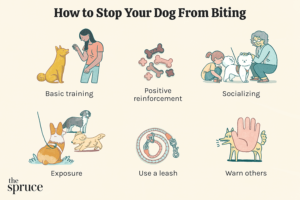Dogs can appear stubborn due to their independent nature or lack of motivation. Training methods that don’t engage them may lead to resistance. Let’s jump in deep: Why is My Dog So Stubborn?
Understanding why your dog seems stubborn can improve your relationship and training outcomes. Many factors contribute to this behavior, including breed characteristics, past experiences, and training techniques. Some breeds are naturally more independent, while others may need more stimulation or rewards to stay engaged.
Frustration can arise when commands are unclear or inconsistent. Recognizing these factors is essential for effective training. With patience and the right approach, you can encourage your dog to respond better. A tailored training plan can transform stubbornness into enthusiasm, making your bond stronger and more enjoyable for both of you.

Credit: lomabehavior.com
Table of Contents
The Myth Of Canine Stubbornness
Many dog owners label their pets as stubborn. This term often causes confusion. Dogs are not stubborn in the way humans are. Understanding this myth can help improve your bond with your furry friend.
Debunking Stubbornness: A Misunderstanding
People often misinterpret their dog’s behavior. They see a lack of response as stubbornness. In truth, dogs communicate differently. Here are some common misconceptions:
- Ignoring commands: Dogs may not understand what you want.
- Picky eating: Some dogs have food preferences.
- Refusal to obey: Fear or distraction may cause this behavior.
Instead of labeling your dog as stubborn, consider these factors:
| Behavior | Possible Reason |
|---|---|
| Not coming when called | Distracted by scents or sights |
| Barking excessively | Seeking attention or signaling a problem |
| Refusing to walk | Fatigue or discomfort |
Canine Psychology: Stubborn Or Miscommunicated?
Understanding canine psychology is crucial. Dogs express emotions differently than humans. They rely on body language and vocalizations. Misinterpretations can lead to frustration.
Consider these points:
- Training methods: Positive reinforcement works better than harsh commands.
- Socialization: Early exposure helps dogs understand expected behaviors.
- Physical health: Pain or illness can affect behavior.
Recognizing these factors can improve your training experience. Build a strong communication channel with your dog. This helps in understanding their needs and behaviors.
Breed-specific Traits And Stubbornness
Understanding why your dog is stubborn often relates to their breed. Different breeds possess unique traits that influence their behavior. Some dogs are naturally more headstrong. Others may be more eager to please. Knowing these traits helps in managing stubbornness effectively.
Inherent Traits In Different Dog Breeds
Each dog breed has specific characteristics. These traits can lead to stubborn behaviors. Here’s a look at some common breeds and their inherent traits:
| Breed | Inherent Trait | Stubbornness Level |
|---|---|---|
| Bulldog | Independent | High |
| Jack Russell Terrier | Energetic | Moderate |
| Shiba Inu | Strong-willed | Very High |
| Golden Retriever | Eager to please | Low |
| Afghan Hound | Independent | High |
Recognizing Breed Predispositions
Identifying breed predispositions helps in training. Here are key points to consider:
- Training Style: Some breeds respond better to positive reinforcement.
- Socialization Needs: Early socialization can reduce stubbornness.
- Exercise Requirements: High-energy breeds need more activity.
- Intelligence Level: Smart breeds may become bored easily.
Understanding your dog’s breed traits aids in effective training. You can tailor your approach for better results. Recognize their strengths and weaknesses to foster a positive relationship.
Communication Barriers Between Dogs And Humans
Understanding why your dog seems stubborn often comes down to communication. Dogs and humans speak different languages. Misunderstandings can lead to frustration on both sides. Learning about these barriers can help improve your relationship.
The Language Gap: Misinterpreting Signals
Dogs communicate through body language, sounds, and behavior. Humans rely on spoken words. This difference creates a gap.
- Body Language: Dogs use tail wagging and ear positions.
- Vocalizations: Barking, growling, and whining express emotions.
- Behavior: Actions like digging or jumping show needs.
Many dog owners misinterpret these signals. For example, a wagging tail often means happiness. But, it can also indicate nervousness. Understanding these nuances helps build trust.
| Dog Signal | Meaning |
|---|---|
| Wagging Tail | Happy or anxious |
| Lowered Ears | Fear or submission |
| Growling | Warning or discomfort |
Improving Your Dog-human Dialogues
Enhancing communication with your dog can reduce stubbornness. Simple techniques can make a big difference.
- Learn Dog Language: Study your dog’s body language.
- Use Consistent Commands: Stick to the same words for actions.
- Positive Reinforcement: Reward good behavior with treats.
- Observe Responses: Pay attention to how your dog reacts.
Try to create a shared understanding. Spend time training and bonding. This approach leads to better communication. Your dog will feel more secure and understood.
Training Techniques And Dog Compliance
Understanding why your dog is stubborn can help improve training. Stubbornness often stems from misunderstandings between the dog and the owner. Effective training techniques can enhance compliance and create a stronger bond.
Positive Reinforcement Vs. Punishment
Positive reinforcement focuses on rewarding good behavior. This method encourages your dog to repeat desired actions. Examples include:
- Giving treats for following commands.
- Offering praise and affection.
- Playing games after successful training sessions.
Punishment, on the other hand, can lead to fear and anxiety. It may not solve stubbornness. Here’s a comparison:
| Method | Effectiveness | Emotional Impact |
|---|---|---|
| Positive Reinforcement | High | Builds trust |
| Punishment | Low | Creates fear |
Consistency: The Key To Training Success
Consistency is crucial for dog training. Dogs thrive on routine and clear expectations. Here are tips for maintaining consistency:
- Use the same commands every time.
- Involve all family members in training.
- Set clear rules and stick to them.
Inconsistent training leads to confusion. This confusion can increase stubborn behavior. Establishing a consistent routine helps your dog understand what you expect.
The Role Of Socialization In Dog Behavior
Socialization plays a vital role in shaping a dog’s behavior. It involves exposing your dog to various people, environments, and experiences. Proper socialization helps dogs develop confidence and reduces stubbornness. A well-socialized dog is more adaptable and responsive.
Early Socialization: Shaping Future Behavior
Early socialization is crucial for puppies. The first few months are a key period for learning.
- Puppies should meet different people and animals.
- Introduce them to various environments.
- Expose them to different sounds and smells.
Positive experiences during this time can lead to:
- Better behavior in adulthood.
- Increased trust and bonding.
- Reduced anxiety and fearfulness.
Without proper early socialization, dogs may become:
- Stubborn and uncooperative.
- Fearful of new situations.
- Overly protective or aggressive.
The Impact Of Social Experiences On Stubbornness
Social experiences shape a dog’s personality. Dogs that have limited interactions may display more stubborn behavior.
| Type of Social Experience | Effect on Behavior |
|---|---|
| Positive Interactions | Increased adaptability and willingness to learn. |
| Negative Experiences | Increased stubbornness and fearfulness. |
| Lack of Exposure | More resistant to commands and training. |
Consistent socialization helps reduce stubbornness. Dogs learn to trust their owners. They also understand expectations better. This leads to a more harmonious relationship.

Credit: blog.greenacreskennel.com
Health Issues That Affect Your Dog’s Behavior
Many dog owners notice stubborn behavior in their pets. This behavior can sometimes mask underlying health issues. Understanding these health problems is crucial for improving your dog’s behavior.
Medical Conditions Mimicking Stubbornness
Some medical conditions can make dogs seem stubborn. Here are a few common issues:
- Arthritis: Pain can make movement difficult.
- Ear Infections: Discomfort can lead to disobedience.
- Vision Problems: Dogs may not respond if they can’t see well.
- Neurological Disorders: These can affect behavior and comprehension.
Each of these conditions can cause your dog to appear stubborn. A visit to the vet can help identify any health issues.
Regular Check-ups: Preventing Misdiagnosis
Regular vet visits are essential for your dog’s health. They help catch issues early. Here are key points to keep in mind:
- Schedule check-ups at least once a year.
- Discuss any changes in behavior with your vet.
- Keep track of any physical changes.
- Ask about vaccinations and preventative care.
These measures can help prevent misdiagnosis. Early detection leads to better treatment options.
Environmental Factors Influencing Dog Behavior
Understanding your dog’s stubbornness involves recognizing environmental factors. These factors can greatly affect their behavior. Stressors in their surroundings may make them less responsive. Creating a nurturing space can also help. Let’s explore these aspects further.
Stressors In Your Dog’s Environment
Stressors can come from various sources. Common stressors include:
- Noise from traffic or construction
- Unfamiliar people or animals
- Changes in routine
- Harsh weather conditions
Each stressor can impact your dog’s mood. A stressed dog may show stubborn behavior. Recognizing these stressors is key to helping your pet.
Creating A Supportive And Nurturing Space
A supportive environment can improve your dog’s behavior. Here are some tips to create a nurturing space:
- Designate a quiet area for rest.
- Use calming scents like lavender.
- Provide safe toys for mental stimulation.
- Maintain a regular feeding and walking schedule.
A stable environment reduces anxiety. Dogs thrive in spaces that feel safe. Your efforts can lead to a happier, more obedient dog.
Building A Better Relationship With Your Dog
Understanding your dog’s behavior is key to a strong bond. A stubborn dog often feels misunderstood. Building trust helps them feel secure. A good relationship leads to better obedience.
Trust And Understanding: The Foundation Of Obedience
Trust forms the core of your relationship with your dog. Dogs need to know you are their safe space. Here are some tips to build trust:
- Be consistent with commands.
- Use positive reinforcement.
- Spend quality time together.
- Learn your dog’s body language.
Understanding your dog’s needs is essential. Each dog has a unique personality. Pay attention to their likes and dislikes. This helps in recognizing stubborn behaviors.
Engaging Activities To Strengthen Your Bond
Engaging in fun activities builds a better relationship. Here are some ideas:
- Daily walks in new areas.
- Interactive games like fetch or tug-of-war.
- Training sessions with treats.
- Agility courses to challenge them.
These activities stimulate both body and mind. They teach your dog to listen and respond. Strong bonds form through shared experiences. This leads to a happier, more obedient dog.

Credit: k9basics.com
Frequently Asked Questions
Why Does My Dog Ignore Commands?
Dogs may ignore commands due to various reasons. They could be distracted, unmotivated, or unsure of what is expected. Consistent training with positive reinforcement can help. Ensure that your dog is engaged and understands the commands clearly. Patience and practice are key to overcoming stubbornness.
Is My Dog Stubborn Or Independent?
Dogs can exhibit both stubbornness and independence. Breeds like terriers are known for their independent nature. However, stubbornness often stems from a lack of training or understanding. Assess your dog’s behavior and training methods. Adapting your approach can improve their responsiveness and willingness to follow commands.
How Can I Train A Stubborn Dog?
Training a stubborn dog requires patience and consistency. Use positive reinforcement techniques, such as treats and praise, to encourage desired behaviors. Break commands into smaller steps for easier understanding. Regular practice in short sessions can enhance focus. Always reward progress, no matter how small.
Are Some Dog Breeds More Stubborn?
Yes, certain dog breeds are known for being more stubborn. Breeds like Bulldogs, Afghan Hounds, and Borzois can be particularly challenging. Their independent nature often leads to resistance during training. Understanding your breed’s characteristics can help you tailor your training approach for better results.
Conclusion
Understanding your dog’s stubbornness can lead to a better bond. It often stems from their personality, past experiences, or breed traits. Patience and consistent training are key. By addressing these factors, you can help your dog become more receptive. Remember, every dog is unique, and so is their behavior.



